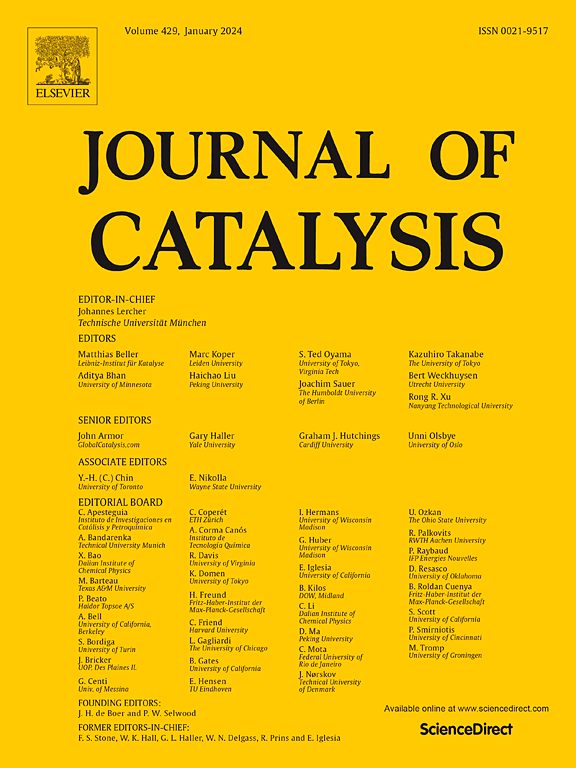Performance of Janus-like type nobel-metal/TiO2 microspherical nanocomposites and application on microplastics photodegradation
IF 6.5
1区 化学
Q2 CHEMISTRY, PHYSICAL
引用次数: 0
Abstract
The persistent environmental pollution caused by microplastics presents a significant challenge, with photocatalytic degradation emerging as a promising solution. However, its efficacy is often limited by ineffective photocarrier separation. This study addresses these limitations by designing Janus-like type photocatalysts comprising silver (Ag) and gold (Au) nanoparticles anchored on hollow TiO2 microspheres (HTMs) via a photoreduction method. The resulting composite photocatalysts, Ag/HTMs and Au/HTMs, were evaluated for their ability to degrade microplastic polyethylene (PE) films. Morphological and compositional analyses using SEM, EDS, and XPS confirmed the successful loading and oxidation states of Ag and Au nanoparticles. Electrochemical characterizations revealed significantly enhanced photocatalytic activities for HTMs and their Janus-like composites, outperforming the performance of commercial P25 photocatalyst. Notably, Janus-like Ag-5/HTMs and Au-10/HTMs exhibited photocatalytic activities that were 90-fold and 60-fold higher than P25, respectively. Under irradiation, Janus-like Ag-5/HTMs achieved the highest degradation efficiency, mediated by reactive species (·OH, O2–·, 1O2, and h+) under ambient conditions. To further demonstrate its practical application, a device was fabricated by spin-coating Ag-5/HTMs onto spherical activated carbon. When applied to swimming pool water containing 98.20 MP/L of microplastics, achieving a high removal efficiency for microplastics. This study underscores the potential of Janus-like M/HTMs systems for the efficient and sustainable degradation of microplastics, advancing their application in environmental remediation.

类janus型诺贝尔金属/TiO2微球纳米复合材料的性能及其在微塑料光降解中的应用
微塑料造成的持续环境污染提出了重大挑战,光催化降解成为一种有前途的解决方案。然而,其效果往往受到光载流子分离效果不佳的限制。本研究通过光还原方法设计了由银(Ag)和金(Au)纳米颗粒锚定在空心TiO2微球(HTMs)上的类janus型光催化剂,解决了这些限制。对制备的复合光催化剂Ag/HTMs和Au/HTMs降解微塑料聚乙烯(PE)薄膜的能力进行了评价。利用SEM、EDS和XPS进行形貌和成分分析,证实了Ag和Au纳米颗粒的成功加载和氧化态。电化学表征表明,HTMs及其Janus-like复合材料的光催化活性显著增强,性能优于商用P25光催化剂。值得注意的是,Ag-5/HTMs和Au-10/HTMs的光催化活性分别比P25高90倍和60倍。在辐照条件下,Janus-like Ag-5/HTMs在环境条件下通过活性物质(·OH、O2 -·、1O2和h+)介导的降解效率最高。为了进一步证明其实际应用,我们将Ag-5/HTMs自旋涂覆在球形活性炭上。应用于微塑料含量为98.20 MP/L的游泳池水中,对微塑料具有较高的去除效率。本研究强调了Janus-like M/HTMs系统高效、可持续降解微塑料的潜力,推进了其在环境修复中的应用。
本文章由计算机程序翻译,如有差异,请以英文原文为准。
求助全文
约1分钟内获得全文
求助全文
来源期刊

Journal of Catalysis
工程技术-工程:化工
CiteScore
12.30
自引率
5.50%
发文量
447
审稿时长
31 days
期刊介绍:
The Journal of Catalysis publishes scholarly articles on both heterogeneous and homogeneous catalysis, covering a wide range of chemical transformations. These include various types of catalysis, such as those mediated by photons, plasmons, and electrons. The focus of the studies is to understand the relationship between catalytic function and the underlying chemical properties of surfaces and metal complexes.
The articles in the journal offer innovative concepts and explore the synthesis and kinetics of inorganic solids and homogeneous complexes. Furthermore, they discuss spectroscopic techniques for characterizing catalysts, investigate the interaction of probes and reacting species with catalysts, and employ theoretical methods.
The research presented in the journal should have direct relevance to the field of catalytic processes, addressing either fundamental aspects or applications of catalysis.
 求助内容:
求助内容: 应助结果提醒方式:
应助结果提醒方式:


